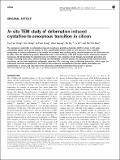In situ TEM study of deformation-induced crystalline-to-amorphous transition in silicon
Author(s)
Zhang, Wei; Zhuang, Zhuo; Ma, En; Shan, Zhi-Wei; Wang, Yue-Cun; Wang, Liyuan; Li, Ju; ... Show more Show less
Downloadam201692.pdf (3.540Mb)
PUBLISHER_CC
Publisher with Creative Commons License
Creative Commons Attribution
Terms of use
Metadata
Show full item recordAbstract
The mechanism responsible for deformation-induced crystalline-to-amorphous transition (CAT) in silicon is still under considerable debate, owing to the absence of direct experimental evidence. Here we have devised a novel core/shell configuration to impose confinement on the sample to circumvent early cracking during uniaxial compression of submicron-sized Si pillars. This has enabled large plastic deformation and in situ monitoring of the CAT process inside a transmission electron microscope. We demonstrate that diamond cubic Si transforms into amorphous silicon through slip-mediated generation and storage of stacking faults (SFs), without involving any intermediate crystalline phases. By employing density functional theory simulations, we find that energetically unfavorable single-layer SFs create very strong antibonding interactions, which trigger the subsequent structural rearrangements. Our findings thus resolve the interrelationship between plastic deformation and amorphization in silicon, and shed light on the mechanism underlying deformation-induced CAT in general.
Date issued
2016-07Department
Massachusetts Institute of Technology. Department of Brain and Cognitive Sciences; Massachusetts Institute of Technology. Department of Nuclear Science and EngineeringJournal
NPG Asia Materials
Publisher
Springer Nature
Citation
Wang, Yue-Cun, Wei Zhang, Li-Yuan Wang, Zhuo Zhuang, En Ma, Ju Li, and Zhi-Wei Shan. “In Situ TEM Study of Deformation-Induced Crystalline-to-Amorphous Transition in Silicon.” NPG Asia Materials 8, no. 7 (July 2016): e291–e291.
Version: Final published version
ISSN
1884-4049
1884-4057